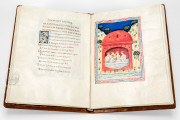The Valencia Baths of Pozzuoli is a manuscript copy of Peter of Eboli's poems praising the therapeutic virtues of the thermal baths of the Phlegraean Fields west of Naples. The manuscript—produced for Alfonso, Duke of Calabria, before he became King of Naples in 1494—is richly illuminated with thirty-six full-page miniatures that give the viewer a good sense of the medicinal, courtly, and bathing culture of early modern Italy. The painted border and initials feature the white vine-stem decoration characteristic of Italian Humanistic manuscripts.
Little is known about Peter of Eboli (also Petrus de Ebulo), a late 12th Century writer of historical-encomiastic and didactic poems. Everything we know about him is largely derived from his work.
The only thing we can be certain of is that Peter of Eboli (in the Campania region, at the time part of the Kingdom of Naples) was a monk, who, under Henry VI, Holy Roman Emperor and King of Sicily, reached the status of court poet.
De Balneis Puteolanis: a Short Poem That Summarizes the Knowledge Contained Within the Schola Medica Salernitana and Popular Medicine
Peter of Eboli possessed a certain medical knowledge, probably acquired in Salerno, home of the prestigious Schola Medica Salernitana, the world’s most noted medical university and, accordingly, Western Europe’s most influential source of medical expertise at that time.
The De Balneis Puteolanis was written before 1197. It describes the thermal baths of the Phlegraean fields, on the Tyrrhenian shore between Naples and Baia. The poem includes 35 epigrams inspired by inscriptions written on ancient stone carvings. Over its six couplets, it celebrates the therapeutic virtues of 35 baths, together with the illnesses they were believed to cure.
An Extraordinary Popular Work of the Time
The De Balneis Puteolanis was written to be "Cesaris ad laudem" – in honour of the emperor – probably Henry VI or Frederick II, whose future deeds the author promises to narrate at the poem’s culmination.
The De Balneis Puteolanis alternately includes both text and miniatures. It is a mirror of a certain type of culture, which encompassed both medical-scientific speculation and empirical-popular practices. Due to its didactic nature, the work was extremely popular in the following centuries (21 manuscripts survive).
The Valencia Manuscript of the De Balneis Puteoli
Now preserved at the University Library of Valencia, the manuscript containing Peter of Eboli’s poem was written and decorated between 1455 and 1459 in Naples, during the reign of Alfonso de Magnanimous. This 297x220 mm codex includes 36 full-page illuminations in 38 folios.
The 38 leaves of the Valencia manuscript of the De Balneis Puteolanis, are penned on vellum, in rounded humanistic script. It includes rubrics and its binding is leather covered. The manuscript includes a complete version of the original De Balneis and the order of the poems is quite close to that of the purported original.
We have 1 facsimile edition of the manuscript "Valencia Baths of Pozzuoli": De Balneis Puteoli (Pietro da Eboli) facsimile edition, published by Scriptorium, 1997
Request Info / Price














